 |
 |
| HMS Dreadnought...the Ship that Started an Arms Race |
|
Mitchell's 1921 bombing exercise was followed by another in 1923, when he sank two obsolete pre-dreadnought battleships: USS New Jersey (BB-16) and Virginia (BB-13) off Cape Hatteras. While the airplane's potential was clear, the Navy's ferocious battlewagons had been the mainstay of the fleet for too long to disappear quietly. Less than a decade after Dreadnought was launched, her revolutionary design was eclipsed by the next generation of battleships�a new class loosely referred to as "super-dreadnoughts." Bigger and more powerfully armed than the first generation dreadnoughts, these behemoths were represented by ships like Orion, King George V, Iron Duke and Queen Elizabeth (643 feet long, 15-inch guns) in the Royal Navy, and the Pennsylvania class (608 feet long, 14-inch guns) in the American Navy. The Queen Elizabeths made up the 5th Battle Squadron during the Battle of Jutland, and after considerable modernization served during the Second World War. Commissioned in 1916, American super-dreadnoughts such as Pennsylvania, Arizona, Nevada and Oklahoma saw only limited duty during the First World War, but were destined for infamy during the Second. | |
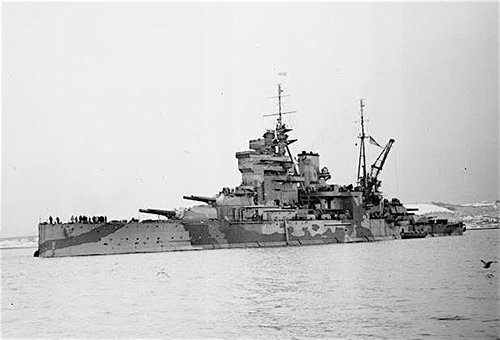 | 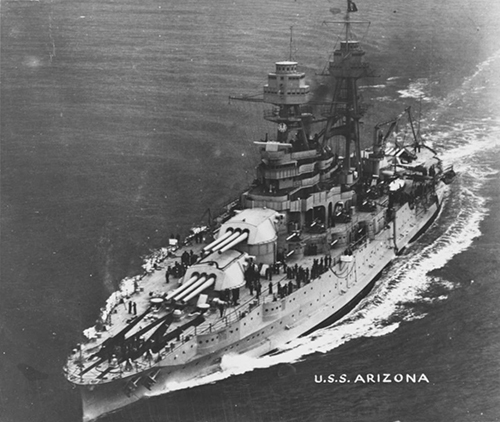 |
| "Super-Dreadnought" HMS Queen Elizabeth--launched in 1913, a veteran of the Battle of Jutland who also served in the Second World War | Launched in 1915, USS Arizona was the American version of the "Super-Dreadnought," and was destined to become the most famous American battleship |
|
While there were many criticisms of Mitchell's bombing tests, certainly one of the more honest was that the ships were anchored, the air attacks occurred in peacetime conditions�and the ships didn't fight back. All of these criticisms were quickly answered in course during the next war. Following the bombing tests, Mitchell was sent on a tour of the Eastern Pacific, including Hawaii, the Philippines, India, China, Manchuria and Korea, and later Japan (as a tourist). Mitchell was convinced that war between the United States and Japan was inevitable. He wrote a long report about his trip, many papers and magazine articles, and in 1925 his popular book Winged Defense. In one paper he wrote: | |
|
"The Island of Oahu, with its military depots both naval and land, it's airdromes, water supplies, the city of Honolulu with its wharves and supply points forms an easy compact and convenient object for air attack . . . I believe, therefore, that should Japan decide upon the reduction and seizure of the Hawaiian Islands the following procedure would be adopted. Ten submarines would be loaded with 6 pursuit airplanes . . . Attack to be made on Ford Island at 7:30 A.M. route to be direct." ("The Pacific Problem," General William Mitchell) |
|
While his attack scenarios varied widely from one writing to another, they all "predicted" an air attack on the Hawaiian Islands by Japanese airplanes, and when it came, it would cripple America's dreadnoughts. | |
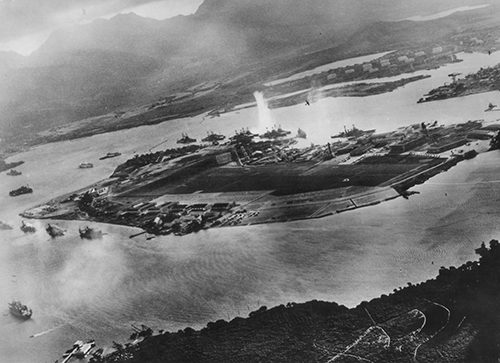 | 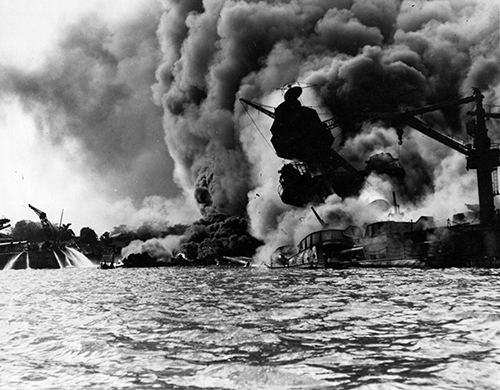 |
| The attack on Pearl Harbor that sank the American dreadnought fleet | USS Arizona burning in Pearl Harbor |
|
December 7, 1941, 7:48 am: As the first wave of Japanese aircraft descended upon Ford Island, seven American super-dreadnoughts were moored in a convenient row, presenting a wartime target set echoing Mitchell's exercises off the Virginia Capes 20 years earlier. Arizona, Nevada and Oklahoma were all commissioned in 1916 in the midst of the First War; West Virginia, California, Tennessee and Maryland were post-war super-dreadnoughts armed with 16" guns, while Utah, moored on the opposite side of the island, was a vintage dreadnought commissioned in 1911 and armed with now diminutive 12" guns. The first wave of 183 Japanese aircraft included 89 Kate torpedo bombers, some carrying armor-piercing bombs and some torpedoes, but all targeting the American Navy's symbol of power�her great battleship fleet. Eight 1760-pound armor-piercing bombs and 13 aerial torpedoes successfully hit their targets, with devastating effect. | |
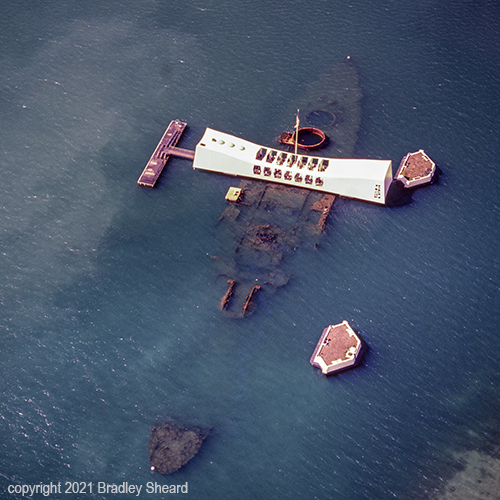 |  |
| USS Arizona Memorial--built over the hulk of America's most famous dreadnought | USS Utah today |
|
Most famously, Arizona was split in two when a bomb penetrated her armor deck and detonated the ship's forward magazine; her memory would forever symbolize America's entry into the Second World War. Since Mitchell's bombing tests two decades earlier, aircraft had begun to carry torpedoes as an effective weapon against ships. Dropped from low altitude by aircraft into the sea, torpedoes proved an effective weapon against warships, and they did much of the damage at Pearl Harbor. Oklahoma was hit by five torpedoes and capsized, while Nevada took six bombs and a torpedo�she was beached before she could sink. Old Utah was hit by two torpedoes and capsized�she still remains on her side where she went down. The newer ships fared no better than the older ones: West Virginia was hit by two bombs and no less than seven torpedoes before going down; California took a pair each of bombs and torpedoes before sinking. Tennessee and Maryland were both hit by a pair of bombs and were damaged, but ultimately didn't sink. America's great battle fleet had been decimated by waves of airplanes launched from the new naval symbol of power�aircraft carriers. What Roosevelt indignantly called an "unprovoked and dastardly attack by Japan" had ushered in the Pacific War. While five of the great battleships were ultimately returned to service following heroic salvage efforts, the losses were yet another signpost on the road to the battleship's obsolescence. | |
|
While the attack at Pearl Harbor was certainly not a peacetime exercise, the ships were stationary--sitting ducks and nearly defenseless. Battleship proponents could still rightly claim that the Japanese attack did not represent a "fair contest" between the two contenders�but that claim could only be made for three more days. The Japanese attack on America was not an isolated incident, but part of a bold plan to take control of the entire southwest Pacific region. That Japan had ambitions in the region was not a surprise to most. Months before the attack on Pearl Harbor, the British decided to dispatch "Force Z" to Singapore to defend her colonial interests and help deter expected Japanese aggression. Consisting of the modern battleship Prince of Wales and the dreadnought-era battlecruiser Repulse and four destroyers, the force arrived in Singapore December 2. Winston Churchill had made the force's mission quite public in an attempt to promote its deterrent effect�he wanted to send Japan a clear message that her ambitions would not go uncontested. Rather than deter Japanese aggression, however, the publicity gave the soon-to-be enemy fair warning and the opportunity to train pilots for an attack on the British capital ships. On December 8 the British force left Singapore with hopes of intercepting a Japanese convoy headed for Malaya. During the night of December 9, believing he had been sighted by enemy aircraft and fearing the element of surprise had been lost, Force Z's commander, Admiral Phillips, aborted the operation and ordered a return to Singapore. The following morning, however, receiving reports of Japanese landings on the coast of Malaya, Phillips again changed course, this time toward the Malaya peninsula with the intention of opposing the landings. The British had been sighted by the Japanese submarine I-58, however, and reported the sighting after attempting a (failed) torpedo attack of her own. The alerted Japanese dispatched nine search aircraft, quickly followed by three air groups totaling 85 land-based aircraft, armed with both bombs and torpedoes, from Indochina in search of the British ships. Late on the morning of December 10�only three days after the infamous attack on Pearl Harbor, the Japanese found the British capital ships. HMS Prince of Wales was a modern battleship born into war in 1941. Designed while the Washington Naval Treaty and the Treaty of London were still in effect, she was "only" armed with 10 x 14-inch main guns, but had a fully modern anti-aircraft armament of 16 x 5.25-inch quick fire guns in twin turrets. Capable of 70-degree elevation and firing 10-12 rounds per minute, they were controlled by four gun directors fitted with radar range finding. In addition, the ship was equipped with six 8-barreled "pom-pom" short-range anti-aircraft guns, also fitted with radar range finders. Prince of Wales was a combat veteran that helped pursue and sink the German Battleship Bismarck in the spring of 1941. During that running battle, she had both scored hits on Bismarck, and taken her share of punishment from the famous German foe in return. HMS Repulse was a dreadnought-era battlecruiser, light on armor but heavily armed with 6 x 15-inch guns. She was capable of 31.5 knots�her designers had intended her to out-run any ship that could out-gun her. She was also born into war, but in her case it was the previous World War. During that conflict, she took part in the Second Battle of Heligoland Bight in 1917, firing 54 15-inch shells and scoring a single hit on the German light cruiser Konigsberg. Between the wars she was re-fit several times, upping her armor protection and anti-torpedo bulge, and her secondary armament was re-arranged several times. She had insufficient anti-aircraft armament going into the Second World War, however, and was destined to succumb to what was quickly becoming the new order of battle at sea. | |
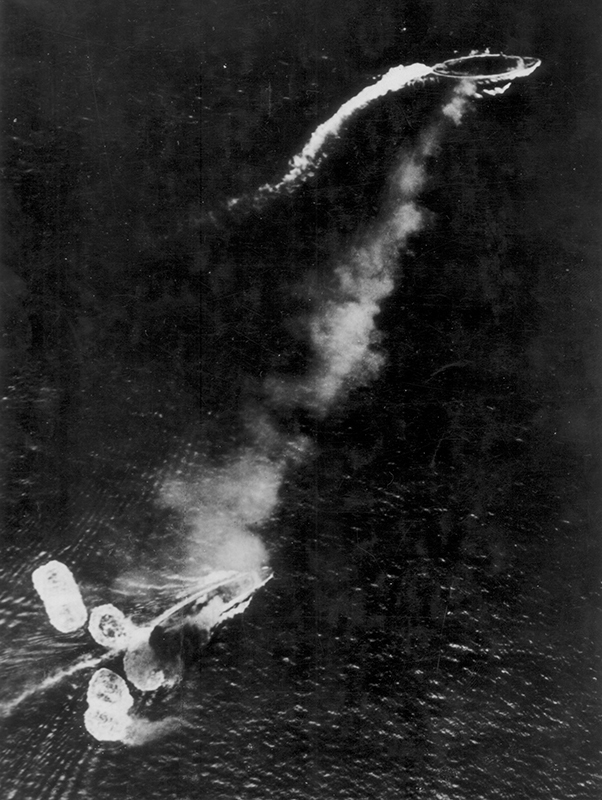 | 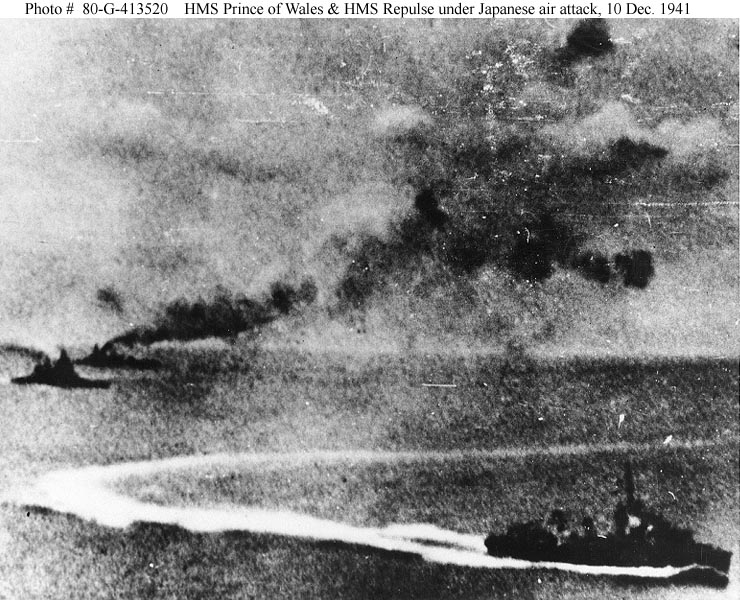 |
| HMS Repulse (bottom) and Prince of Wales (top) under attack | HMS Prince of Wales (far left) and Repulse (far left, behind) |
|
The first attack came at 11:15 am, when eight high-level bombers flew overhead, concentrating on Repulse. Only a single hit was scored on the veteran battlecruiser, doing little damage. This initial attack was followed 20 minutes later by two squadrons of torpedo bombers; Repulse managed to turn away and "comb" the torpedoes, but Prince of Wales turned toward her attackers and failed to evade all the weapons, and was hit by two torpedoes. One missile struck beneath the aft 14-inch turret, and the second hit home in the propellers. Prince of Wales quickly took on a list and her speed dropped to 15 knots. A third squadron of nine torpedo bombers appeared and went after Repulse, who once again managed to evade the torpedoes. Meanwhile, another group of aircraft dropped bombs from above, and although they missed their target, the battle was quickly becoming a chaotic, one-sided contest as the British ships were overwhelmed by attacking aircraft. A group of eight "Betty" bombers split into two groups and attacked Repulse from both sides�the ancient battlecruiser was helpless to turn away and took hits amidships. Four of the aircraft continued on and launched their weapons against the now-crippled Prince of Wales, scoring three more hits on the already listing battleship. Repulse was still steaming at 25 knots more than an hour after the first attacks had begun, but the Japanese had the upper hand and were not about to let up. Another torpedo squadron appeared on the scene and bore down on their target from different directions, limiting Repulse's ability to steer clear of the weapons. The first hit jammed her steering gear, and three more torpedoes quickly hit home, leaving Repulse listing badly and clearly sinking. Meanwhile, Prince of Wales was making only eight knots with her after decks awash. Another squadron of bombers droned overhead, dropping yet more bombs but doing little additional damage, but the battleship's fate had already been sealed, and she soon capsized and sank, as Repulse had already done 50 minutes earlier. The survivors were picked up by the accompanying destroyers, which the remaining Japanese aircraft left alone. Force Z had been completely destroyed, and 840 sailors had lost their lives in another triumph of aircraft vs. battleship. | |
|
March 2001, Malaysia: After endless travel, from Seattle to Tokyo, to Singapore by air, to Tioman Island via ferry and finally by dive boat offshore, we arrive at the scene of a momentous World War II battle, and anchor over the wreck of HMS Repulse. The sea is very calm, but visibility is limited to 40-50 feet on the bottom by a cloudy haze of fine silt stirred up by the gentle current that seems ever present on the bottom; it would be lovely to have more, but it is enough to work with. On my first dive to this historic shipwreck I swim to the bow, passing the muzzles of massive 15-inch guns sticking out of their turrets, half-buried beneath a partially inverted hull. The great battlecruiser lies port-side-down, halfway between inverted and on her side. Her superstructure was broken when she rolled over, and today is incompletely buried and spread across the ocean bottom--yet the entire stretch of her hull from forward turret to stem stands clear of the sand. At the very tip of her bow, a tripod flagstaff juts intact from the gunwale, now surrounded by schooling fish and pointing downward toward the sand, while the elegant curve of her upside-down stem towers overhead. | |
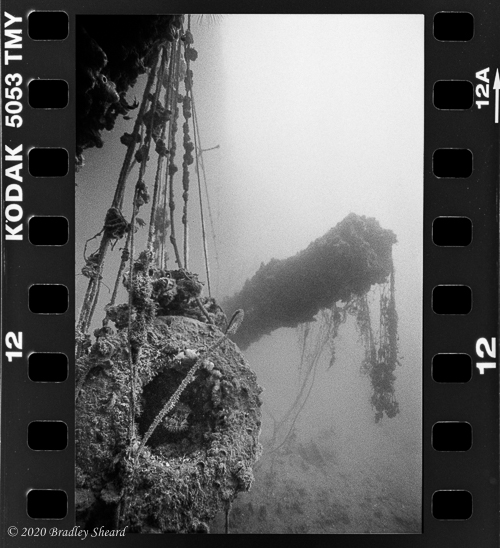 | 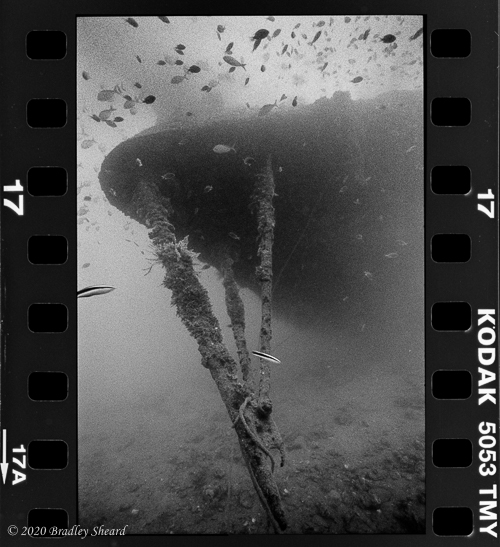 |
| HMS Repulse's 15-inch guns protruding from the ocean bottom | A tripod flagstaff is still in place at the very tip of the ship's bow |
|
We spent the next several days exploring the wreck, and the more I poked around the superstructure of the battlecruiser, the more I realized how intact she really is. Structures near and on her main deck seemed nearly perfect, with only the upper works bent and broken into mangled expanses of rusting steel. The 4-inch gun turret, and nearby "pom-pom" anti-aircraft guns, seem to be sitting intact on their mounts, only appearing at a haphazard angle because of the ship's current strange orientation. Scattered about are the crushed remains of "Carley floats"�tubular life rafts intended for the crew in times of emergency. Swimming to the extreme stern on one dive, I am buzzed by a pair of marauding sharks as I examine the ship's propellers. A clear torpedo hole is evident near one of the propeller shafts--one of five torpedo hits she suffered at the hands of Japanese aircraft. | |
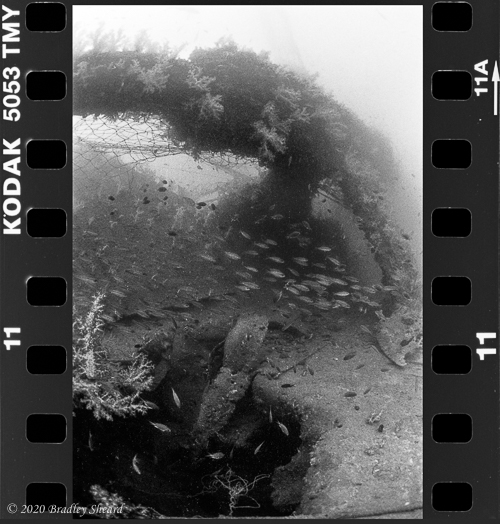 | 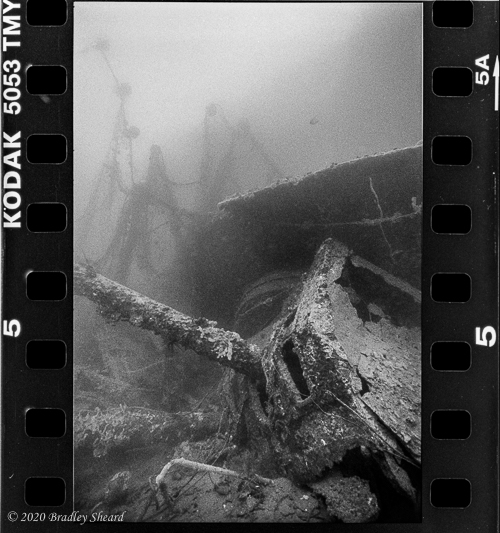 |
| One of the ship's propeller shafts, with a clear torpedo hole beneath it | One of Repulse's triple 4-inch gun turrets |
|
Several days later we anchored over the other famed wreck from this great battle: HMS Prince of Wales. Although nearly the same length as Repulse, this massive ship was broader, bulkier and more heavily armored, with a much larger displacement. Landing on top of her completely inverted hull, the immense size of this monster is immediately obvious. Anchored near the ship's stern, the huge propellers and shafts welcome us to her grave. Two of the massive propellers are still in place on the starboard side, with the forward, outboard shaft clearly bent from one of the torpedo hits that led to her sinking. Only one of the port side propellers is still there, with the outboard one missing, either from battle damage or salvage efforts. Large torpedo damage holes are evident on both sides of the ship's stern near the shafts; it was those torpedo hits that crippled the vessel, ultimate leading to her loss. | |
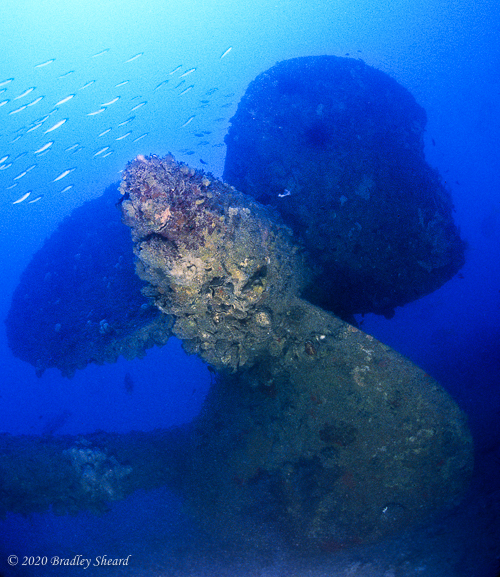 | 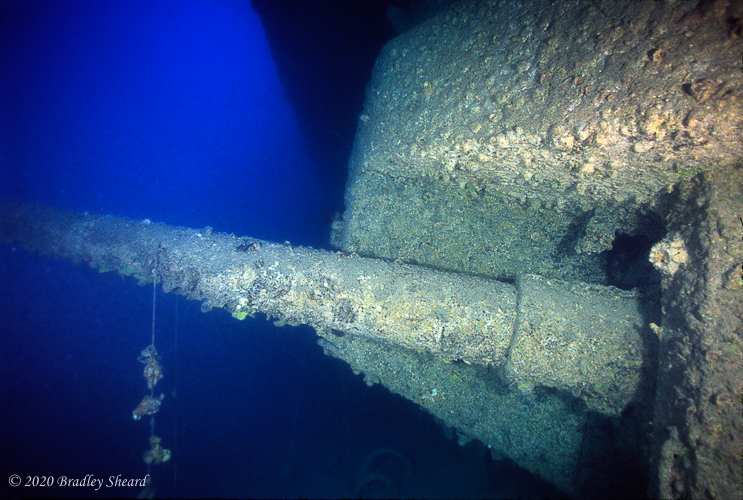 |
| HMS Prince of Wales' propellers are one of the few recognizable features on her inverted hull | A 5.25-inch gun turret hangs inverted beneath the battleship's hull |
|
Dropping over the starboard side, a twin 5.25-inch gun turret hangs inverted beneath her decks, guns pointed to starboard. Further forward, another 5.25-inch turret is visible with its guns pointing into the sand below (skyward in the non-inverted ship), as if still in action against the attacking Japanese aircraft. Swimming further forward still, we are able to squeeze beneath the ship's main deck and get a glimpse of her main armament�a quadruple turret containing 14-inch guns. Three of the guns are still visible, although barely, while the fourth is completely buried in the sand beneath the massive hull looming over our heads. It was these very guns that unleashed multiple salvos at the German battleship Bismarck in the famous chase that sank that German ship earlier in the war; now they lay half-buried in a silty bottom beneath a slowly collapsing mountain of steel plate. | |
|
There are some ships that just seem to live forever. USS Arkansas was launched in January 1911, five years after HMS Dreadnought. Armed with twelve 12-inch guns placed in six turrets, she was driven by four steam turbines and wore prodigious amounts of armor plate; she and her brethren were America's answer to the dreadnought revolution. Her first taste of wartime conditions occurred in October 1913, when she participated in troop landings in Veracruz, Mexico after a coup in that country. Although it seems a rather minor military baptism, two Arkansas sailors lost their lives during the effort. When America entered the First World War in 1917, Arkansas found herself on the US East Coast where she would spend 14 months on patrol duty. In July 1918, however, she was sent across the Atlantic to join the British Grand Fleet as part of the 6th Battle Squadron. Although she saw no major combat in the conflict, following the Armistice Arkansas participated in the internment of the German High Seas Fleet in the Firth of Forth before its fateful journey to Scapa Flow. Following the war's conclusion Arkansas assumed peacetime duties, including several cruises in European waters. As the ship aged, she underwent a series of modernization overhauls. Her coal-fired boilers were replaced with oil-burning units, and additional deck armor was installed to resist plunging shell fire�one of the lessons of Jutland. When the European continent again plunged into conflict in 1939, the United States tried to remain neutral, but gradually found herself drawn into the conflict. In May 1940, British forces invaded neutral Iceland because of her strategically important location in the Atlantic sea lanes. Despite America's neutral status, in July 1941 US Marines relieved the British and took over the occupation; Arkansas served as one of the escorts for the US Marine force sent to the island nation. | |
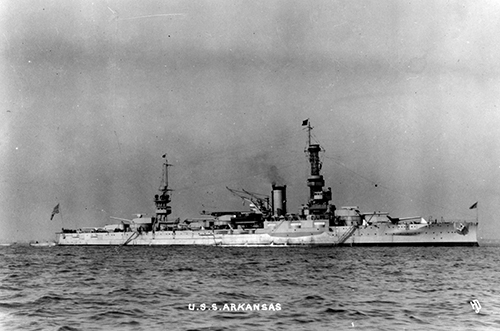 | 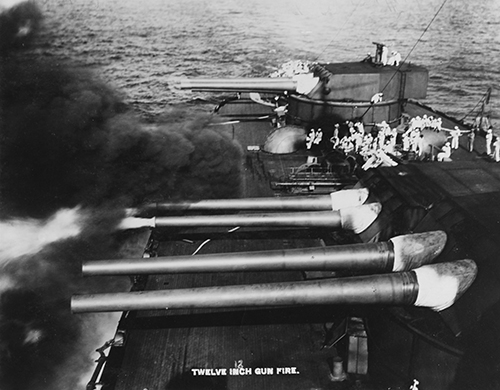 |
| American dreadnought USS Arkansas | 12-inch guns unleashing a broadside |
|
In August 1942, after America officially entered the war, the mature battleship began escorting Atlantic convoys to both Europe and North Africa, for Operation Torch. When the Allied invasion of the European continent began in June 1944, Arkansas was in the thick of the action, stationed off Omaha Beach providing shore bombardment of German forces. This was followed by supporting the Allied attacks against Cherbourg, France a few weeks later. In August, she shifted to the Mediterranean to provide support for the invasion of the South of France. Built for long-range, ship-to-ship slug-fests with other dreadnoughts, the development of combat aircraft had rendered her original mission nearly obsolete. Yet the behemoth still possessed a deadly suite of guns capable of lofting 870 pound explosive shells at enemy fortifications, giving her a new mission and lease on life. In early 1945 Arkansas entered the Pacific war, where she supported the invasion of Iwo Jima. Her big guns provided much needed bombardment of Japanese shore positions--the same role she had served for D-day in Europe. During the invasion of Okinawa that followed, Arkansas once again delivered punishing salvos on Japanese positions with her big guns, continuing this support for 46 days. At this point in the war the desperate Japanese had begun their famous kamikaze tactics, and Arkansas was subjected to a number of these suicide attempts, all unsuccessful. Following Okinawa, the veteran battleship took part in operations in the Philippines until the war finally ended in August 1945. After the peace treaty with Japan was signed, Arkansas took part in transport operations returning American soldiers home to the United States. Now a 35-year veteran of both peace and two world wars, Arkansas had one last duty to fulfill for her country. In a modern echo of Billy Mitchell's bombing demonstrations of 1921, mankind's new weapons of mass destruction were scheduled for tests to determine their effectiveness against naval targets. "Operation Crossroads" took place at Bikini Atoll in July 1946, where a fleet of 95 ships was anchored in the lagoon. In the first test, nicknamed "Able," a B-29 aircraft dropped a nuclear bomb on the assembled fleet. The drop was slightly off-target, limiting the damage to the ships. While the military considered the test a disappointment, five ships were sent to the bottom by a single bomb. | |
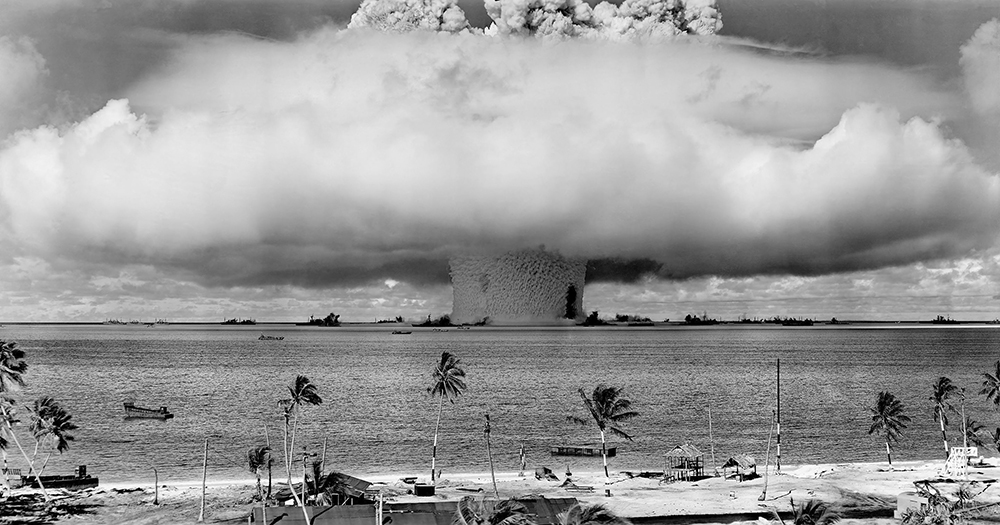 | |
| The "Baker" blast at Bikini Atoll that sank ten ships, including USS Arkansas | |
|
The second test scheduled was an underwater detonation of the same weapon. Suspended 90 feet beneath a landing craft, test "Baker" was more effective, sinking ten ships including the battleships Arkansas and Nagato, and the aircraft carrier Saratoga. Arkansas was the closest ship to the detonation (other than the ship the bomb was hung beneath), and she sank some 19 seconds after the blast. A new generation of bombs had arrived providing the ultimate power of destruction. General Billy Mitchell would undoubtedly be pleased. | |
|
June 1996, Marshall Islands: Fifty years after a nuclear explosion sent one of America's first dreadnoughts to the bottom of a remote Pacific atoll, I'm aboard a small dive boat anchored over the ship's remains. Newly opened to scuba tourists, the island has been deemed safe for visitation, so long as you don't eat anything that grows here! USS Arkansas, one of the last remaining relics of America's great dreadnought fleet, lies largely upside down on the lagoon bottom, port gunwale propped up off the sand by the forward gun turrets, and perhaps her remaining superstructure, buried beneath the sand. Dropping down the mooring line to the midships portion of the dreadnought's hull, we come face-to-face with a lone 5-inch gun, still protruding droopily from its armored casemate. Swimming forward along the ship's port gunwale, we find it propped high enough above the sand to allow access beneath the ship's main deck. Two big 12-inch guns point out to port from her forward turret�-massive weapons that once threw high-explosive shells against both German and Japanese fortifications. Reaching the ship's bow we find the still beautiful lines of Arkansas' stem and forefoot towering over the sea floor, remarkably intact considering the blast that must have shaken the ship's very bones. An overgrown anchor chain pours out of the port hawsepipe, disappearing into the sand below, while wild strands of whip coral grow up toward the sunlight like the spines of a porcupine. | |
After a long swim aft, over increasingly flattened and distorted hull plates, we come to what remains of the stern. At least one of the port propellers still sits on its shaft, held up by the shaft struts above a sandy bottom and flattened hull plates. Most of the stern itself seems to be either missing or buried beneath the sea floor, and what is visible appears to have been squashed by some mythic, Godzilla-like creature. The propeller itself is shrouded in a massive tangle of finger-like whip coral, with schools of tiny fish darting in and out of what looks like a undersea bamboo forest. USS Arkansas, veteran of two World Wars, numerous battles and two nuclear explosions, now lies peacefully beneath the calm waters of a tropical lagoon--surely she has earned her restful grave. |
All images, text and content Copyright © Bradley Sheard. All rights reserved.